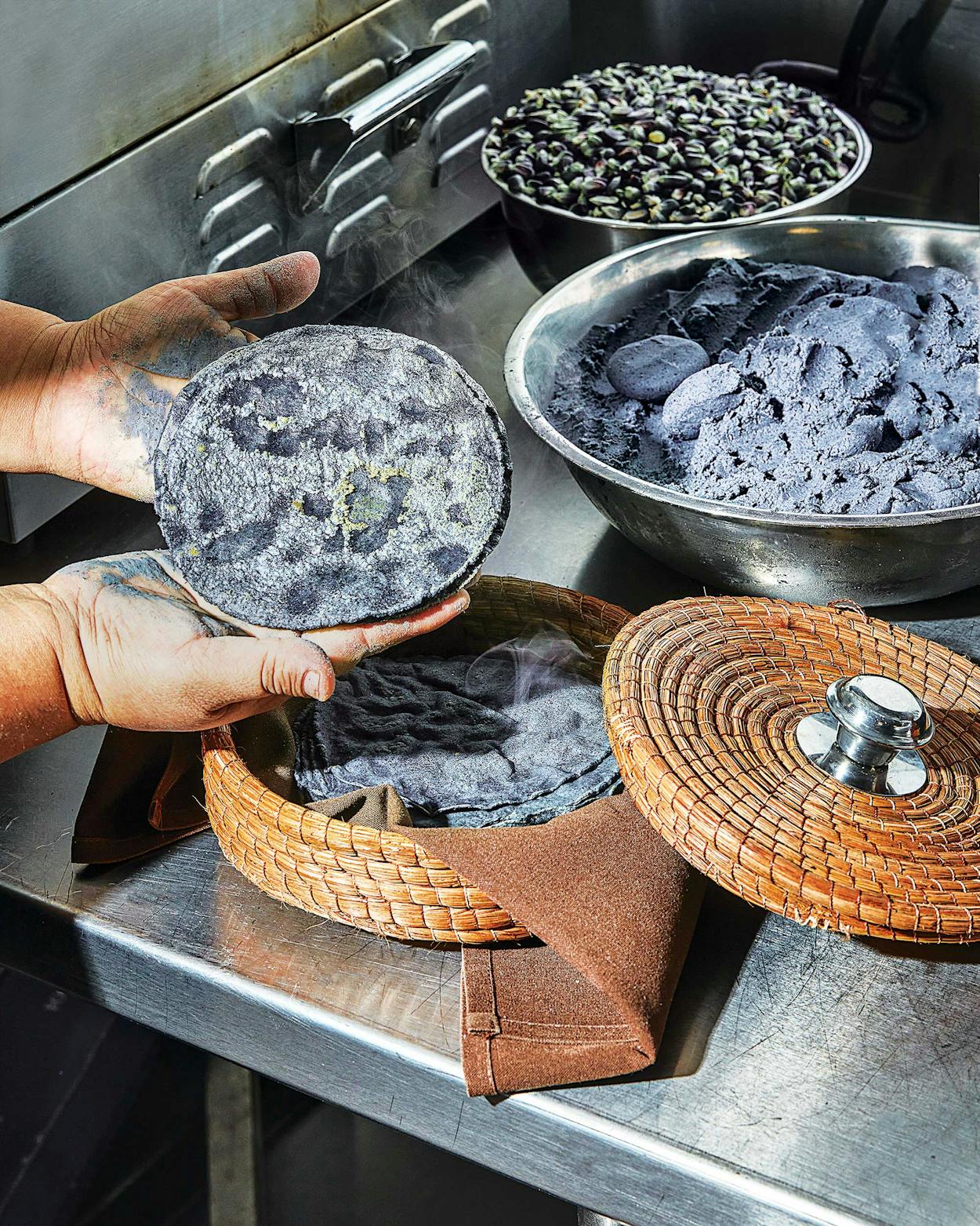It was the fall of 2021 when the first of ten eighteen-wheelers rolled into Fort Worth from Mexico. Most of the trucks originated in Saltillo, an industrial city of about a million located some 170 miles southwest of Laredo. A few of the trucks came from Mexico City, another 430 miles south. For more than six months they rumbled north, one roughly every three weeks, filled to the brim with dining tables and chairs, pecan-wood doors, disassembled decorative woodwork for cabinets, sets of tableware, leather menu covers, hefty tortilla presses, clay planters and pots, and 20,387 terra-cotta bricks. Oh, and twelve massive handmade wooden looms ready to be strung with miles of thick, white cotton thread.
This caravan was arriving at a time when COVID had forced dining venues across the country to shut their doors or at least switch to takeout service. But at a strategically chosen site next to the Cultural District, two old friends were putting their reputations, not to mention their life savings, on the line.
Until recently, Adrián Burciaga, who had grown up in a small city near Saltillo, had managed the restaurant at the Modern Art Museum of Fort Worth. Juan Ramón Cárdenas, a member of a well-known restaurant family in Saltillo, was the chef and owner of a popular upscale chophouse there called Don Artemio, the name an homage to Artemio de Valle-Arizpe, a Saltillo-born novelist and gourmand who had been friends with artists Diego Rivera and Frida Kahlo. For years, Burciaga, 47, and Cárdenas, 54, had idly talked about opening a location in this country, but the timing was never right. Suddenly, though, everything changed. When Burciaga called Cárdenas in September 2020 to tell him he’d lost his job—“I’m a free agent!” was how he put it—the latter said, “Hold on. Don’t do anything. I’m coming to Fort Worth.” Five days later they were sizing up a dozen vacant restaurant sites.


On a Saturday night almost two years after that, three friends and I found ourselves at a pleasant corner table in a spacious room whose gleaming glass walls gave no indication that the building had once housed a Mr. Gatti’s. The contents of the truck caravan filled the room: tables of polished wood, blue-and-white dishes, and the occasional decorative novelty, such as a small turquoise paleta cart retooled to distribute tequila. The 20,387 terra-cotta bricks had become rustic interior walls and bar fronts. As for the massive looms, eleven now loomed overhead as light fixtures and art installations, a decorative tribute to the legendary weavers of Saltillo.
The four of us looked at the concise menu and made a unanimous decision: an order of fried nopalitos for the table, please. Normally I’m of two minds about prickly pear cactus. The taste is fine, a little like tart green beans, though the texture once it’s cooked can be slimy. But julienned, deep-fried, and tossed with bacon bits? That’s a whole other story. We mounded spoonfuls atop thin house-made tortillas, which we gently folded into tacos. “We get heirloom corn from Tlaxcala and Oaxaca and prepare the masa here,” said Burciaga, who has naturally assumed the role of Don Artemio’s manager and genial host. Cárdenas is the culinary director, visiting once a month. On hand every night is the executive chef, his 24-year-old son, Rodrigo.
Now seriously hungry, we briefly considered pork belly confit with black-bean puree but were distracted by something more unusual in these parts: cabrito. The menu offered two preparations, one a roasted kid in a brothy tomato sauce sided by a purple-cabbage salad. But my favorite was the second, fork-tender confited cabrito stuffed into a row of pretty chiles güeros (small, plump yellow peppers) and topped with pumpkin seeds.
Saltillo is a landlocked city, but seafood is a staple at the original Don Artemio and is proving to be equally popular in the landlocked city of Fort Worth. A lovely pink slab of Norwegian salmon, lightly grilled, arrived in a generous pool of pipián verde, a complex light and green pumpkin seed-rich mole. Steamed mussels came with their glistening black shells immersed in a smoky chipotle-and-leek sauce (the clunky house-made potato chips that accompanied them were not in the same league).
The most interesting seafood dish was the Chilean sea bass in mole negro. The sauce, a many-hour labor of love, involved a market’s worth of chiles (chief among them the fruity chilhuacle negro, of Oaxaca) and ranked among the top five versions I’ve ever had. As for the fish, which I ended up sampling on two visits, the texture was perfect one time, inexplicably mushy the other.


Balancing out the fish and lighter meats is a small, well-edited selection of steaks (the Wagyu strip loins and massive tomahawks are on display in a glass-fronted dry-aging refrigerator in the dining room). After some debate, we ended up with a precisely medium-rare USDA Prime ribeye from local Rosewood Ranches, a throw-caution-to-the-winds indulgence lavished with earthy porcini cream and served alongside a Camembert potato puree.
Our dessert choice was simple but demonstrated the kitchen’s flair for drama. Called a Deconstructed Tres Leches, it turned out to be white cake with fresh berries and a side of homemade vanilla ice cream that had been frozen into the shape of a shell. With Instagram potential obviously in mind, the chefs had elevated the defining “three milks” sauce into a table-side pour-over.
We were in no hurry at the end of the meal, so at Burciaga’s suggestion, we wandered down a short hallway with him to peek into the private dining room that holds the restaurant’s growing wine collection. “We have around a hundred labels,” he told us, from France, Mexico, Spain, and the U.S., with more being added all the time. He’s especially pleased with two Gran Reservas—a cabernet sauvignon and a Shiraz—from Coahuila’s respected Casa Madero, one of the oldest wineries in the Americas, founded in 1597.
The next day, I was back with other friends to try brunch, which turned out to be exactly the treat we wanted on a Sunday morning. The menu offered dishes for traditionalists, including sunny-side-up eggs in a meaty, robustly seasoned (almost too much so) chorizo-based sauce. There were also enfrijoladas covered with black bean sauce and stuffed with (rather dry) scrambled eggs. But honestly, if you’re at an interior Mexican restaurant, why not be a little adventurous and try chapulines, as in fried grasshoppers? The ones served here are of excellent quality, and if you get them as an add-on for an order of guacamole, all you’ll notice is that they’re delightfully salty and crunchy. And their toasty brown color is pretty against the creamy green mashed avocado.
If I can’t persuade you to try insects, then at least sample another national favorite, tacos de lengua, chunks of luscious beef tongue sautéed in salsa verde and swaddled in tortillas warm from the griddle. Or, if you’re truly famished, go for the chilaquiles de pato: a hearty casserole of moist duck confit mixed with crispy broken-up tortillas; on top are melty splotches of mild panela cheese and pretty streaks of crema. For dessert, skip the pedestrian pan dulce and go for something fun and silly and utterly Mexican: French toast covered in melted Glorias. These goat-milk-and-pecan candies are sold by the bagful all over northern Mexico and make a sweet, tangy, almost caramel-like sauce.
Fort Worth is abundantly supplied with Mexican restaurants, cafes, and taquerias. With the exception of venues opened by recent immigrants, most are Tex-Mex. Fine dining, with a menu that reflects a particular region of Mexico, has always been a harder sell. The goal of Don Artemio is to change that. Says Burciaga, “We wanted to bring traditional Mexican cooking with high-quality ingredients and an upscale environment” to Fort Worth. With their moles and pipianes, seafood and steaks, grasshoppers and Glorias, they’ve done just that.
Don Artemio
3268 W. 7th, Fort Worth
817-470-1439
L Mon–Fri. D 7 days. B Sat & Sun.
$$$
Opened March 21, 2022
This article originally appeared in the September 2022 issue of Texas Monthly with the headline “Purple Maize.” Subscribe today.
- More About:
- Pat’s Pick
- Restaurant Reviews
- Mexican Food
- Fort Worth









